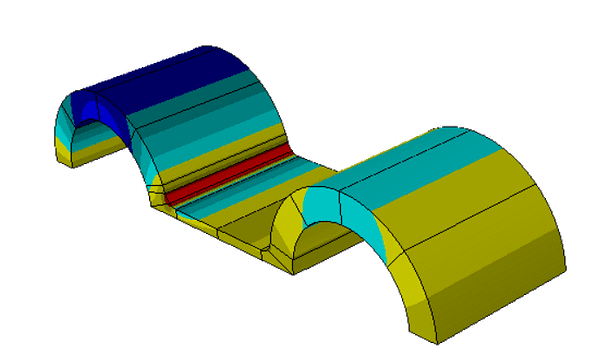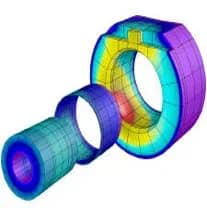With the Heat Transfer Solver, you can solve thermo-elastic problems with ease by switching between heat transfer and elasticity on the fly. In StressCheck, a linear heat conduction analysis can progress to a nonlinear analysis—seamlessly.
Heat Transfer Solver

The Heat Transfer Solver supports linear, steady-state heat conduction with prescribed temperature, flux and convective boundary conditions. Also supports radiation and temperature dependent materials. Temperature-dependent material properties can be specified as a formula or as tabular data. The computed temperature distribution can be used in a very convenient way for computing the load vector for thermo-elastic problems. Simply solve the heat transfer problem, switch reference/theory selector from Heat Transfer to Elasticity, apply constraints to the model and solve.
Key Features and Advantages
- Applicable to planar, axisymmetric and three-dimensional problems
- Predict problems with linear, steady-state heat conduction with prescribed temperature, flux and convective boundary conditions.
- Radiation and temperature dependent material properties
- A thermo-elastic problem can be easily simulated by applying a Heat Transfer Analysis temperature distribution to the same mesh in elasticity as a thermal load.
- Simply select the Heat Transfer Analysis solution as a loading condition and StressCheck will automatically apply the thermal distribution to the mesh

StressCheck’s unique hierarchic modeling framework makes it easy to pass from a linear heat transfer analysis (convection) to a nonlinear heat transfer analysis (radiation). Simply apply a radiation boundary condition and use the Non-Linear Solver.
Looking for Resources?
Recent News & Events
Quick Links
Testimonials
-
“Aerospace materials scientists and structural engineers now have a new state-of-the-art software product called StressCheck, which provides efficient and reliable analysis tools for composite bonded aircraft structures. A composites research team from the aeronautics industry, known as the Composites Affordability Initiative (CAI), has just completed an extensive study of current capabilities in the area of failure analysis tools for composite bonded joints. This study led the CAI team to unanimously choose StressCheck as the software tool to replace as well as radically improve existing industry standard software currently used to size bonded joints.”
Air Force Research Laboratory (AFRL)
 Serving the Numerical Simulation community since 1989
Serving the Numerical Simulation community since 1989 





